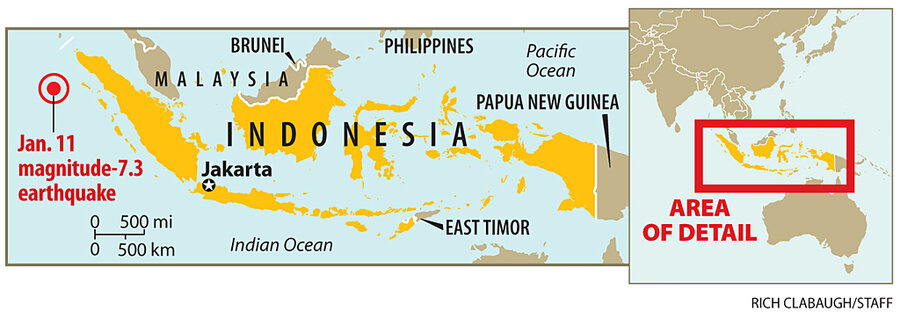7.3 quake hits Indonesia again, but this time residents are better prepared
Loading...
| Jakarta, Indonesia
Just hours after a 7.3-magnitude earthquake struck off the coast of western Indonesia early Wednesday morning, stirring panic and a tsunami alert but leaving no visible damage, life had returned to normal.
It was a forceful reminder for residents of Banda Aceh, the city closest to the devastating 2004 earthquake and Indian Ocean tsunami that killed more than 230,00 across South East Asia.
But despite lingering fears of the Dec. 26, 2004 monster wave that killed roughly 170,000 people in Aceh alone and altered the social fabric of the region, Rahmadi, who owns a small perfume shop in Banda Aceh says people are more prepared than they were a little over six years ago because of government programs.
“My parents put all our important things to a bag, and they know which road to use to escape,” says Rahmadi.
The US Geological Survey reported that the quake struck after midnight 261 miles southwest of the provincial capital of Aceh. On the nearby island of Simeulue, where the quake registered a 7.6 magnitude, according to Indonesia’s meteorology and geophysics agency, a hospital evacuated patients as a precaution.
Rahmadi says the earthquake was longer than smaller ones that routinely hit the area.
“The ground just kept shaking and shaking,” says the man, who goes by one name. “Everybody was outside. People’s faces were panicked.”
Warning sirens blaring from neighborhood mosques stirred most residents from their slumber. Many merely gathered nervously in the streets, but some hopped in cars and on motorbikes and drove away from the sea.
Rahmadi said some of his neighbors stayed outside for more than an hour after the quake, mostly because they feared a tsunami. “They were worried to go to back to sleep.”
Nervous, but better informed
Despite their nervousness, much of resident's better understanding of earthquake and tsunamis come from efforts by the National Agency for Disaster Management (BNPD), the United Nations Development Program and international aid agencies to distribute information to residents about how to respond to natural disasters.
The UNDP frequently publishes information in local newspapers and hands out leaflets about disaster mitigation, says 20-something Rahmadi, who like many of his generation are less fearful of potential tsunamis than their elders. “Older people still don’t understand,” he says.
The disaster management agency has an annual budget of $550 million for preparedness activities, disaster risk reduction, response, rehabilitation, and reconstruction, says its chief Sutopo Purwo Nugroho.
That money has gone toward the formation of local-level disaster management agencies, trained volunteer disaster responders and helped create a disaster management plan and map demarcating high-risk areas. BNPD has also provided reconstruction equipment and logistical assistance to the province.
Mr. Nugroho says the reason yesterday's quake did not cause widespread damage is because its epicenter was far away from the mainland, and residents immediately responded by leaving their homes and heading to safer locations.
One witness told local reporters that about 100 people had gathered on a bridge in the city to check if there was any change to the surface height of the river, an indicator of a possible tsunami. In 2004 the sea off the coast of Aceh rapidly retreated after the magnitude 9.1 quake, and a wall of water swept over the city.
Still hurdles
Not all efforts at disaster mitigation have met with success, however.
In October 2010, a magnitude 7.0 earthquake and tsunami near the Mentawai Islands, west of Aceh, stirred criticism of the government’s attempts to install a widespread warning system after an expensive alert that comprised ocean buoys failed. Indonesian officials later said fishermen had tampered with the technology inside the buoys.
The recovery effort following the 2004 disaster also took considerable time in Aceh, a fairly remote province, and the site of a 30-year conflict between Acehnese separatists and the Indonesian military at the time of the tsunami.
But by 2010 the UN Development Program issued a report praising the rebuilding effort, calling progress there “remarkable.”
The meteorologic agency, which routinely issues tsunami warnings for earthquakes above magnitude 7, lifted its tsunami alert two hours after the quake. Local officials say there have been no major reports of damage or injuries.






